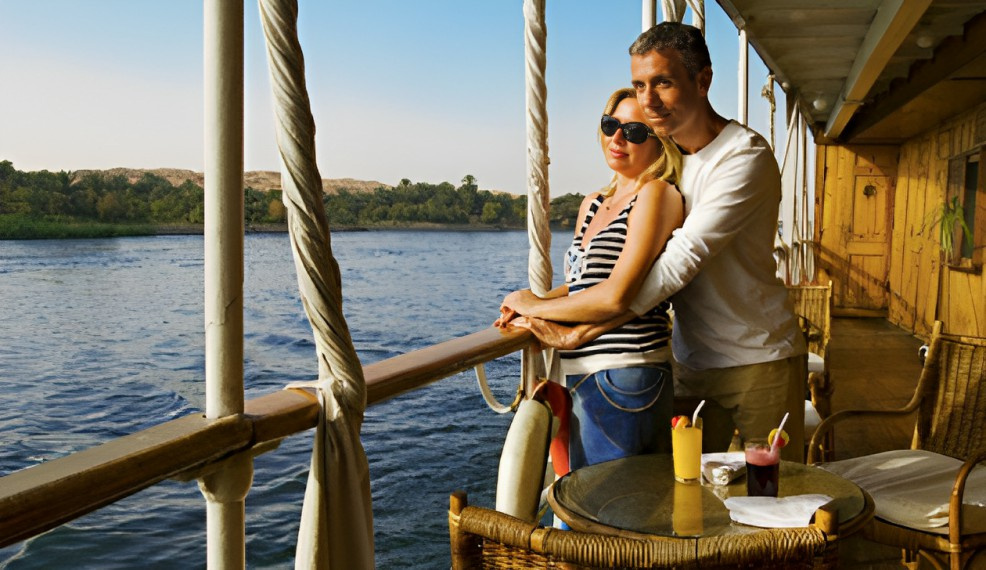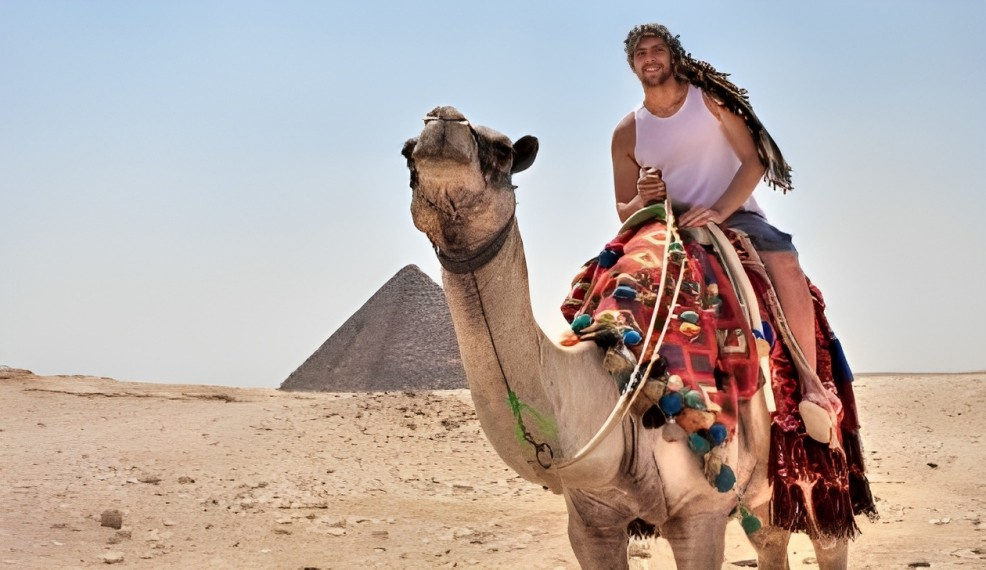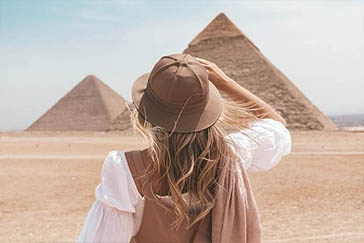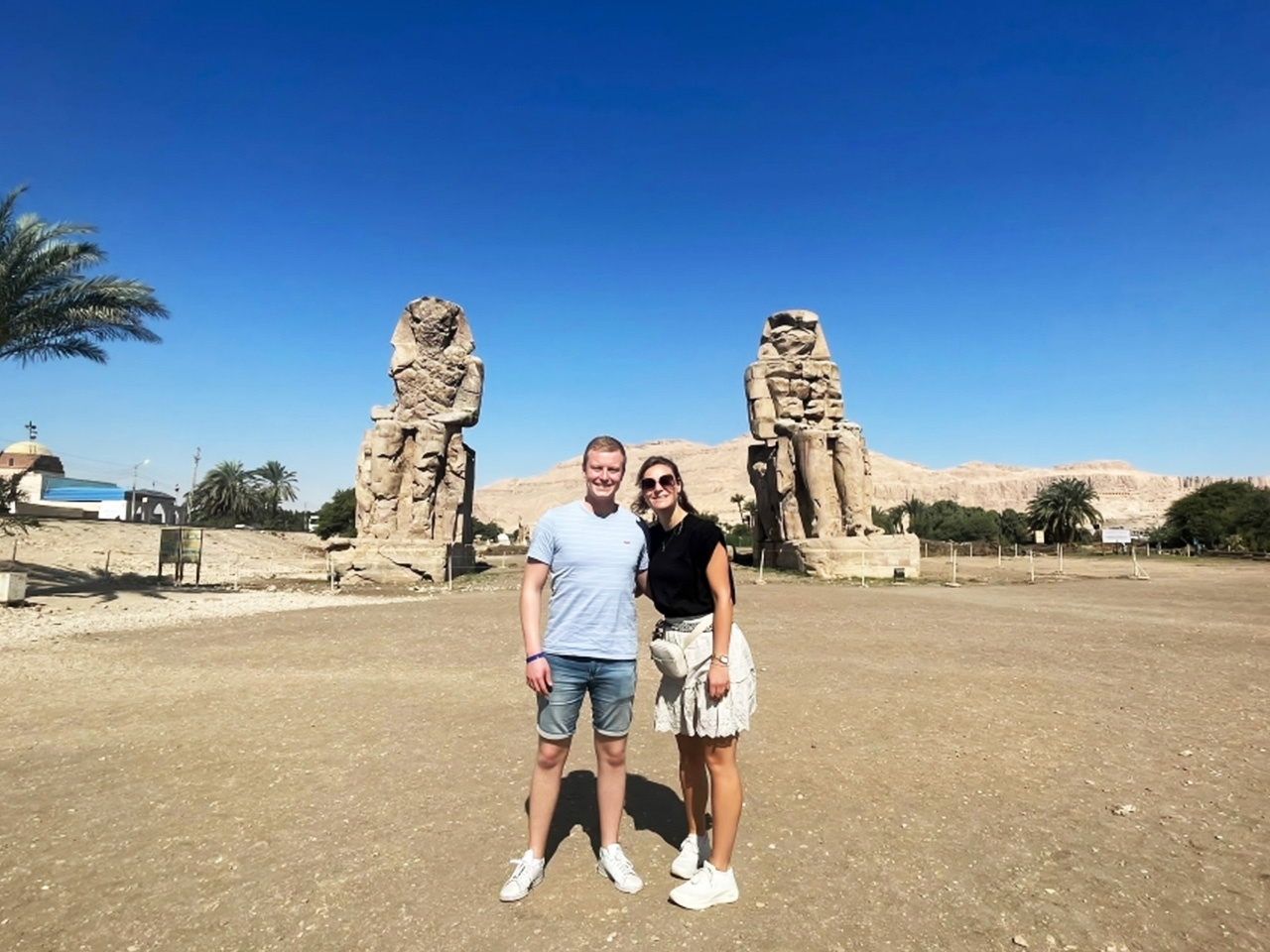15 days Egypt itinerary Cairo, El Minya and Nile cruise
15 Days Egypt overland and Nile cruise Itinerary, Visit Cairo, The Pyramids of Giza, Alexandria and Baharya Oasis.Travel to El Minya Visit Tell Amarna, Abyods,explore Luxor,the Valley of the Kings,Karnak,then Visit Aswan attractions and Abu Simble

15 Days Egypt overland and Nile cruise Itinerary, Visit Cairo, The Pyramids of Giza, Alexandria, Egypt's second-largest city, has many reasons to be famous. Alexandria , and Baharya Oasis. Travel to El Minya Visit Tell Tell El Amarna, also known as Amarna or Akhetaten, is an archaeological site in Egypt that holds great historical and cultural significance. Amarna , and Abyods. Explore Luxor, the Used as a burial chamber for nearly 500 years, the Valley of the Kings was used for royal burials for the Kings,their families, and their possessions. Valley of the Kings , and Karnak, then Travel to Aswan, Visit Esna, Edfu and Kom Ombo, and then Visit Aswan attractions and Abu Simbel on the Nile Cruise.
Egypt Tours Packages is a travel company that specializes in offering a variety of tour packages for those looking to explore Egypt. Egypt Tour Packages representative will meet & assist you at Cairo International Airport, Transfer to the hotel by private air-conditioned vehicle
Depends on your arrival. If you have an early flight to Cairo you can contact us to make a tour suggestion.
Free evening Overnight in the Hotel

Our tour guide will pick you up from your hotel in Cairo or Giza at 8:00 am and get ready for your Private day tour to the Pyramids of Giza with a Private tour guide
First, you will visit the Great Pyramid of Giza (also known as the Pyramid of Khufu or the Pyramid of Cheops), which is the oldest and largest of the pyramids in the Giza pyramid complex. It is the oldest of the Seven Wonders of the Ancient World, and the only one to remain largely intact.
The Great Pyramid of Giza is the largest Egyptian pyramid and served as the tomb of pharaoh Khufu, who ruled during the Fourth Dynasty. The Great Pyramid was built as a tomb for the Fourth Dynasty Egyptian pharaoh Khufu and it is estimated that it was built in the 26th century BC around 27 years.
Initially standing at 146.5 metres (481 feet), the Great Pyramid was the tallest man-made structure in the world for more than 3,800 years. Throughout history, the majority of the smooth white limestone casing was removed, which lowered the pyramid's height to the present 138.5 metres. What is seen today is the underlying core structure. The base was measured to be about 230.3 metres (755.6 ft) square, giving a volume of roughly 2.6 million cubic metres (92 million cubic feet), which includes an internal hillock
Then you will visit the Pyramid of Chephren or Khafre. This r is the second-tallest and second-largest of the 3 Ancient Egyptian Pyramids of Giza and the tomb of the Fourth Dynasty pharaoh Khafre (Chefren), who ruled c. 2558−2532 BC
Then, you will visit the Step Pyramid at Sakkara, which is considered the world's oldest major stone structure. It was built in the 3rd Dynasty for King Djoser.
Then Proceed to have your lunch at a local restaurant.
Overnight in Cairo
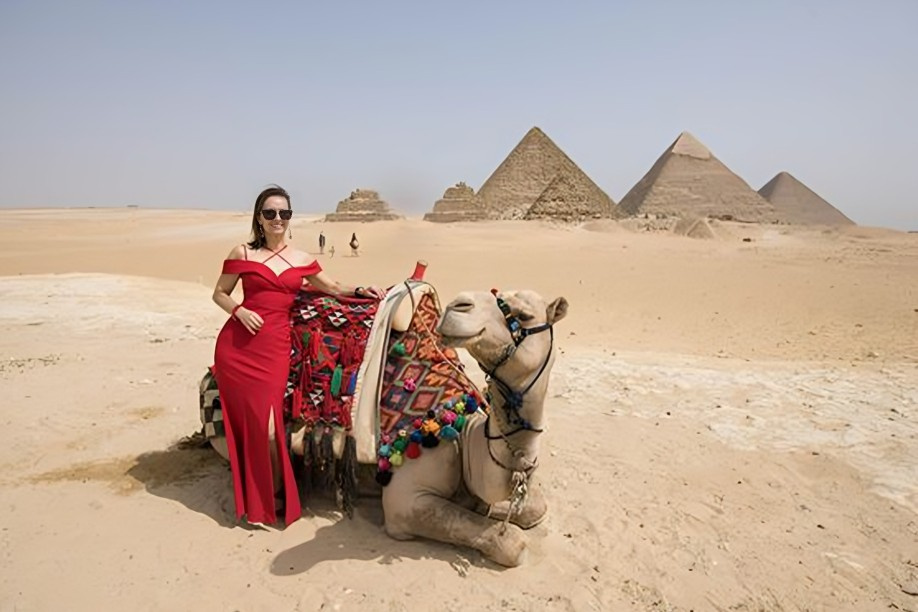
You will be picked up from your hotel to enjoy the Cairo Day Tour to Memphis was one of the oldest and most important cities in ancient Egypt, located at the entrance to the Nile River Valley near the Giza plateau. Memphis and Dahshur Pyramids. You will start with Memphis was one of the oldest and most important cities in ancient Egypt, located at the entrance to the Nile River Valley near the Giza plateau. Memphis which was founded by King Menes and was the capital of Egypt during the Old Kingdom, it was considered to be a centre of rule and culture for over 3000 years and the first capital of Egypt, and see the Statue of Ramses II and the Alabaster the Great Sphinx is one of the world's largest monuments. It is also one of the most recognizable relics of the ancient Egyptians. Sphinx of Memphis was one of the oldest and most important cities in ancient Egypt, located at the entrance to the Nile River Valley near the Giza plateau. Memphis .
Then drive to Dahshur, Two of the later pyramids constructed here have been destroyed by time, and the elements and several others, such as the Black Pyramid (12th Dynasty, 1929-1885 BC), are badly damaged, but Dahshur also boasts two of Egypt’s best-preserved early pyramids. Both built during the reign of King Sneferu (2613-2589 BC), the founder of the 4th Dynasty, the The Bent Pyramid, constructed by Pharaoh Sneferu during the Old Kingdom, is an ancient Egyptian pyramid situated in the royal necropolis of Dahshur. Bent Pyramid , and the The Red Pyramid, also called the North Pyramid, is the largest of the pyramids located at the Dahshur necropolis in Cairo, Egypt. Red Pyramid at Dahshur are massive evidence of the architectural development that led to the construction of the Great Pyramid and companions at Giza.
Then Proceed to have your lunch at a local restaurant.
Then drive to your hotel.
Overnight in Cairo

Start your private tour to
Alexandria, Egypt's second-largest city, has many reasons to be famous. Alexandria
from Cairo, starting at 7:00 am with Pickup from your hotel by our Egyptologist, and transfer by Private A/C Vehicle to
Alexandria, Egypt's second-largest city, has many reasons to be famous. Alexandria
, The distance is 220 km Northwest of Cairo. Arrive at
Alexandria, Egypt's second-largest city, has many reasons to be famous. Alexandria
around 10 am.
Start your day Tour in
Alexandria, Egypt's second-largest city, has many reasons to be famous. Alexandria
by Visiting The Roman
Alexandria, Egypt's second-largest city, has many reasons to be famous. Alexandria
Learn about the catacombs here.
The Catacombs of Kom El Shoqafa is one of the most historically important archeological sites in
Alexandria, Egypt's second-largest city, has many reasons to be famous. Alexandria
Learn about the catacombs here. Catacombs of Kom el Shoqafa
The Catacombs Kom el Shoqafa :
Archaeologists believe that the Catacomb of Kom el Shoqafa was started in the 2nd century A.D. and was used to intern the dead for the next 200 years. This was a period in the history of the city of Alexandria, Egypt's second-largest city, has many reasons to be famous. Alexandria when there was a great mixture of different cultures. Of course, there was the ancient history of the great Egyptian kingdoms which went back thousands of years
Pompey Pillar:
Has nothing to do with Pompey. The story behind the name refers to the possible burial ground of the Roman general when he fled to Egypt and was assassinated after losing a major battle in Greece against Caesar. The red granite column was probably built to honour Emperor Diocletian. Today it stands 25 meters high and is the tallest ancient monument in Alexandria, Egypt's second-largest city, has many reasons to be famous. Alexandria
Alexandria, Egypt's second-largest city, has many reasons to be famous. Alexandria
City was built on the old lighthouse location after it was destroyed by the earthquake. The Citadel of Sultan Qeitbay :
The Citadel was built in the 15th Century by the Mamlouk Sultan Qeitbay, To Guard the City against the threat of Crusaders, This wonderful Islamic Monument was built by the use of the ruins of the old Lighthouse that was constructed by Ptolemy 11 in the 3rd Century B.c. The Lighthouse was damaged during an Earthquake that Occurred in Egypt in 1303 A.c during the reign of the Mamlouk King Qeitbay
Lunch in Alexandria, Egypt's second-largest city, has many reasons to be famous. Alexandria in an Egyptian Restaurant
The new Library of Alexandria, Egypt's second-largest city, has many reasons to be famous. Alexandria :
The Library of Alexandria, Egypt's second-largest city, has many reasons to be famous. Alexandria was reborn in October 2002 to reclaim the mantle of its ancient namesake. It is not just an extraordinarily beautiful building; it is also a vast complex where the arts, history, philosophy, and science come together. Moreover, the myriad activities it offers have made it a place for open discussion, dialogue, and understanding.
Meals: Breakfast in the hotel and Lunch during the trip
Overnight in Cairo
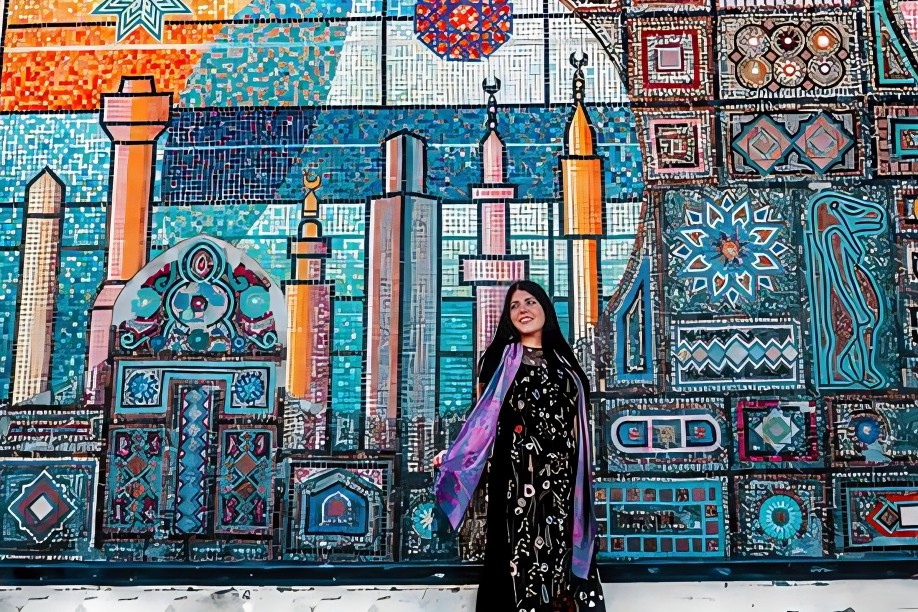
At 06:00 am Pick up time from your hotel in Giza or in Cairo, and drive to Bahariya Oasis, which is located about 350 km east of Cairo This journey takes about 4 hours, in Past when people from Bahariya wish to go to the Nile valley, they often waited until a caravan was passing through, They travelled between the Nile and the oasis in three days( How lucky we are today!!!!!
There will be 2 Coffee Breaks during the trip.
You will see to the righthand side the railways that transport the iron ore deposits to the Steel mill at Helwan, So it is of no use for tourists- Baharyia oasis is the main source of Iron ore of Egypt. The Iron ore comes from the middle Eocene limestone and is located 4 places called Managim
At 10:00 You will arrive at Baharyia oasis then you meet your Safari guide and you will take your 4x4 Jeep and Start your adventure.
Drive to the black desert This name stems from the fact that there is a layer of black powder covering its mountains, highlands, and sand. This powder covers the summits of some mountains
12:00 The Lunch will be served here in El Haize oasis which is located 37 k.m from Bawiti, Some people refer to this oasis as a separate oasis, during the roman time area was very Prosperous, and many of the current families were originally from Libya., Before lunch, you can immerse yourself in a hot water spring which will almost instantly reduce stress. The heat naturally coaxes tense muscles to loosen up which in turn promotes feelings of calm, well-being, and tranquillity.
There is a museum here called the (water museum ) which is built to show the people the importance of the underground water for the people of the desert and the instruments which were used by the Egyptians to raise the water for irrigation
13:00 Then drive to the valley of Agabat
14:00 Arrive at the Valley of Agabat is deep within the white desert white-desert Egypt 360. You have to be there to feel the out-worldly beauty of the place. Millions of years ago, the place used to be under the sea. Over the years, unique rock formations of limestone, chalk (and maybe sand) developed.
Then you will adventure the desert by discovering the Wadi el Agabat by Jeep 4x4 and Enjoy sandboarding
16:30 Explore the white desert white desert Egypt 360 National Park, the most well-known desert destination in Egypt.
There are hundreds of images here each one is reminiscent of an animal- A chicken- A sphinx, Camels, tents, Mushrooms
The chicken-shaped rock
17:30 Make tents and Enjoy the sunset
18:30 As the sky turns pink then the deepest fiery orange, the rock-shapes fade, and silence is all around. Sitting around a small fire and enjoying the simplest meal of chicken, rice, and vegetables, you will feel like nothing has ever tasted so good. Bedouin staff will arrange dinner and desert camping. ( Vegetarian food is available )
Note: at night temperatures can drop suddenly in the White Desert a proper jacket would be necessary to spend the night comfortably- But don't worry we provide all camping equipment like sleeping bags, tents and mattresses.

At 06:00 am Enjoy the sunrise
At 07:00 Am you'll enjoy breakfast in the desert, before driving to Bahariya Oasis
At 09:00 On the way back, you will visit Crystal Mountain, locally known as Gebel al-Izzaz. It's more of a crystal hill, seen on the right, which is often called the Jewel of the desert is formed by quartzite crystals and looks amazing in the sun's rays. A few decades ago, that natural feature was found by accident.
11:00 Drive to Bahariya Oasis , Soak in the heat at Bir Sigam , a hot spring that can help to relax. Located at 7 km east of Bahariya on the Cairo road, the spring is the best hot spring in temperature in The summertime will stop at Bir Madi( which is a cold spring)
Then, drive to el Minya - Overnight in el Minya

You will be picked up by our tour guide from your hotel in Al Minya. You will visit Tuna el Gebel which is the large site that functioned as a Necropolis for the ancient town of Khum or Hermopolis, The Cemetery was located 11 K.m from the City, in an area which is perhaps, better known as the northwestern boundary of the Akhnaton`s City of Akhenaton and it is marked by a boundary stela, We will visit the tomb of Petosiris, the high priest of Thoth and the tomb of the Isadora.
Then, drive to Bani Hassen:
Beni Hasan is an ancient Egyptian cemetery. It is located approximately 20 kilometers to the south of modern-day Minya. Beni Hasan is an ancient Egyptian cemetery. It is located approximately 20 kilometres to the south of modern-day Minya in the region known as Middle Egypt, the area between Asyut and Memphis was one of the oldest and most important cities in ancient Egypt, located at the entrance to the Nile River Valley near the Giza plateau. Memphis . While there are some Old Kingdom burials at the site, it was primarily used during the Middle Kingdom, spanning the 21st to 17th centuries BCE (Middle Bronze Age).
Overnight in Al Minya

You will be picked up by our tour guide from your hotel in Al Minya and Drive to Abyods on the way You will visit Tel El Tell El Amarna, also known as Amarna or Akhetaten, is an archaeological site in Egypt that holds great historical and cultural significance. Amarna , Tell El Amarna, also known as Amarna or Akhetaten, is an archaeological site in Egypt that holds great historical and cultural significance. Amarna palaces and houses. In the new city, Akhenaten built royal palaces and homes for senior officials and workers. The remains of these palaces and houses were found and included many royal statues and heads. Here we will suffice by referring to the large royal palace located in the center of the capital. It was built of mud bricks and stones. The floor of the palace was decorated with scenes, including scenes of birds flying in the swamps, and the walls were decorated with scenes of servants at work.
Then, drive to Abydos
Overnight in Abydos
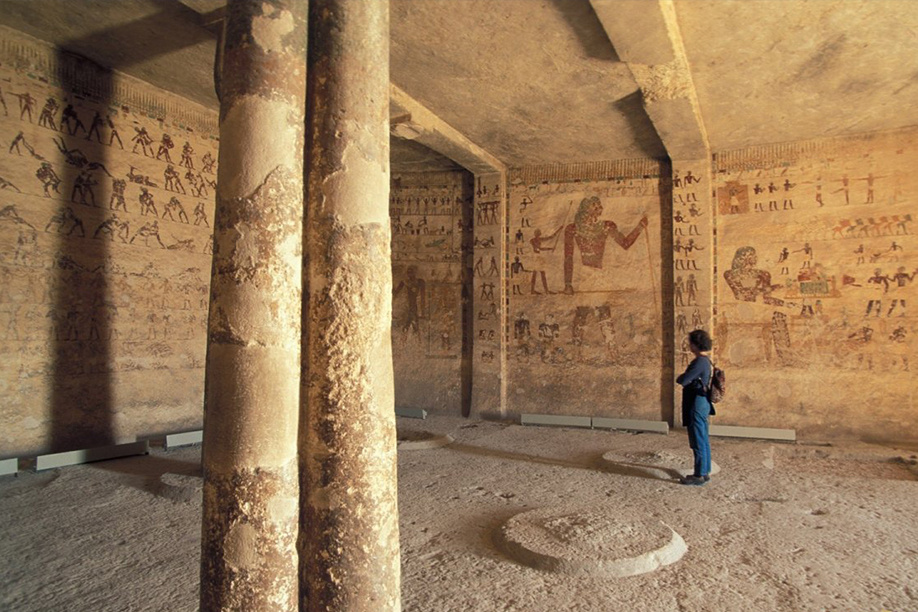
After breakfast, Pick up time from your hotel in Abydos then drive to Abyods
Considered one of the most important archaeological sites of Ancient Egypt, the sacred city of Abydos was the site of many ancient temples, including Umm el-Qa'ab, a royal necropolis where early pharaohs were entombed. These tombs began to be seen as extremely significant burials and in later times it became desirable to be buried in the area, leading to the growth of the town's importance as a cult site.
Abydos was one of the most important religious sites to ancient Egyptians. Much like modern Muslims hope to complete a pilgrimage to Mecca at least once in their lifetime, ancient Egyptians would have hopes to visit Abydos, which for them was strongly associated with entrance into the afterlife.
Although there were several temples constructed here, the largest and most significant is known as the Temple of Seti I. Seti I was the father of the great Ramesses II, who actually completed the construction of most of the temple after his father’s death.
Then drive to Dendera temple?
Dendera temple:
The Temple of Hathor was largely constructed during the Late Ptolemaic period, specifically during the reign of Ptolemy XII and Cleopatra VII. Later additions were made during the Roman period. Although built by a dynasty of rulers who were not native Egyptians themselves, the design of this temple has been found to be in accordance with that of other classical Egyptian temples, with the exception of the front of the hypostyle hall, which, according to an inscription above the entrance, was constructed by Emperor Tiberius.
Apart from these, there are also scenes in the temple complex portraying the Ptolemaic rulers. For example, carved onto the external face of one of the temple walls is a huge relief of Cleopatra VII and her son by Julius Caesar and co-ruler, Ptolemy XV (better known as Caesarion). The two Ptolemaic rulers are shown dressed in Egyptian garb, and offering sacrifices.
Hathor was also regarded as a goddess of healing, and this is evident in the presence of a sanatorium in the temple complex. Here, pilgrims would come to be cured by the goddess. Sacred water (which was made holy by having it poured onto statues inscribed with sacred texts) was used for bathing, unguents were dispensed by the priests of Hathor, and sleeping quarters were provided for those hoping that the goddess would appear in their dreams, and so aid them.
Drive in Luxor and overnight in Luxor.

Pick-up time from the hotel in Luxor and transfer to the cruise
Embarkation and lunch on board the Nile Cruise, proceed with the Visits to the Eastbank of the Nile Including:
The Karnak Temple was built between 2055 BC and around 100 AD. It was built as a cult temple and was dedicated to the gods Amun, Mut, and khonsu. Karnak temple :
No site in Egypt is more impressive than Karnak. It is the largest temple complex ever built by man and represents the combined achievement of many generations of ancient builders and pharaohs. The Temple of Karnak has three main temples, smaller enclosed temples, and several outer temples situated on 247 acres of land.
Optional Tour: One-Hour City Tour in Luxor
by Horse Carriage
Witness a unique amazing trip with the horse carriage to see the daily life and the Egyptian market, also to see the downtown and discover the hidden gems, the tour atmosphere is amazing, and you will feel like an Egyptian.
Luxor Temple located on the east bank of Nile River in the city called luxor , it was known in the egyption language as Luxor Temple :
The Temple of Luxor was the centre of the most important festival, the festival of Opet. Built largely by Amenhotep III and Rameses II, the temple's purpose was as a setting for the rituals of the festival. The festival was to reconcile the human aspect of the ruler with the divine office.
In the Evening you can enjoy An Optional tour Sound and Light Show at Karnak:
The show starts with a historical introduction covering the birth of the great city of Thebes and the erection of the Karnak Temple. The show narrates the glorious achievements of some great Pharaohs as you listen to a magnificent and poetic description of the artistic treasures and great legacy that the The Karnak Temple was built between 2055 BC and around 100 AD. It was built as a cult temple and was dedicated to the gods Amun, Mut, and khonsu. Karnak temple encloses.
Dinner and overnight on board the Cruise in Luxor.
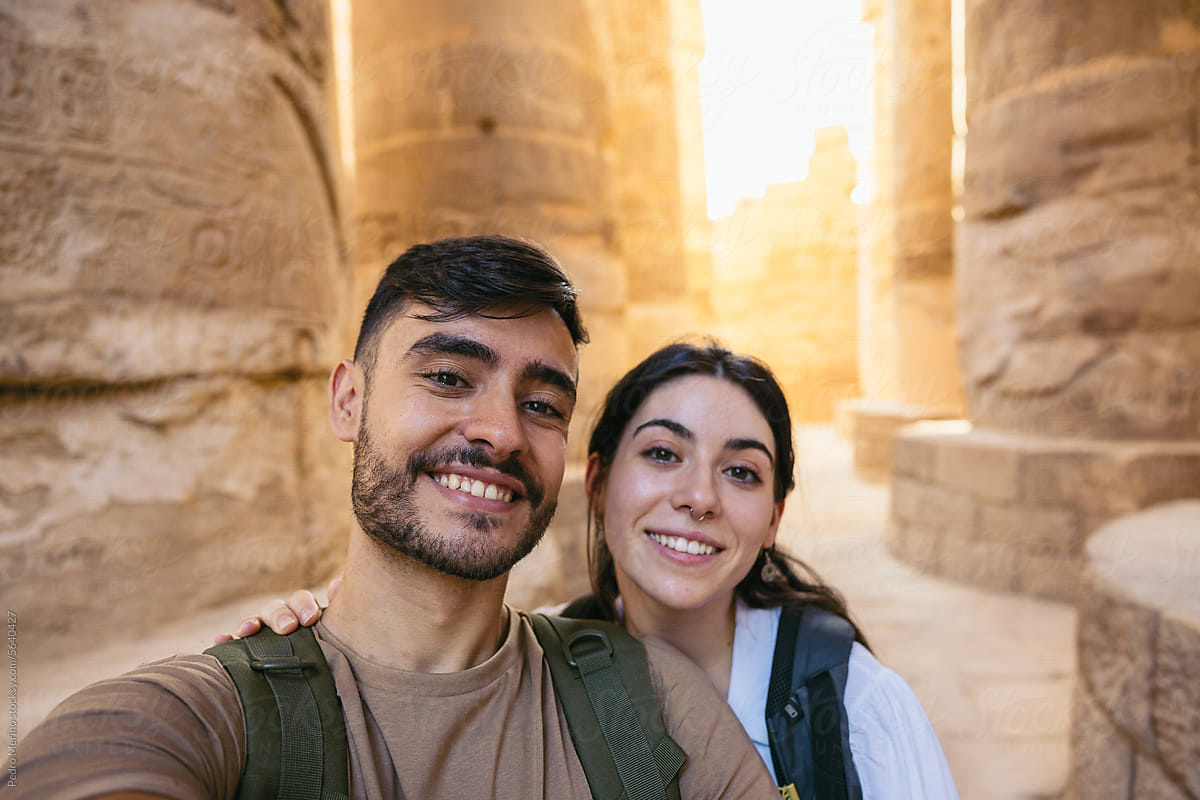
Optional trip Balloon ride over the Used as a burial chamber for nearly 500 years, the Valley of the Kings was used for royal burials for the Kings,their families, and their possessions. Valley of the Kings 100 $ per person:
Get your cameras ready for a stunning balloon ride over the historic town of Luxor. Catch the rays of the early morning sun illuminating the city and its surrounding mountains. Get a bird's eye view of Luxor's ancient sites from aboard a hot air balloon
Breakfast on board the Nile cruise. Visit the west bank of the Nile Including:
The final resting place of Egypt's rulers from the 18th to 20th dynasty, it is home to tombs including the great pharaoh Ramses II and boy pharaoh
Tutankhamun, ruled as a boy only for a short time. He is most famous because his tomb was discovered almost intact and full of treasures in 1922 Tutankhamun
.
The tombs were well stocked with all the material goods a ruler might need in the next world. Most of the decoration inside the tombs is still well preserved.
Optional Extra tombs:
The tomb of Tutankhamun, ruled as a boy only for a short time. He is most famous because his tomb was discovered almost intact and full of treasures in 1922 Tutankhamun is the only tomb in the Used as a burial chamber for nearly 500 years, the Valley of the Kings was used for royal burials for the Kings,their families, and their possessions. Valley of the Kings that was discovered nearly intact in 1922. The discoverer of his tomb was Howard Carter. Tut's famous golden mask is on display at the Egyptian Museum in Cairo, but here you have the opportunity to be amazed at the royal mummy of the young king.
The Tomb of Ramses VI:
The Tomb is One of the largest and most beautifully decorated monuments in the Used as a burial chamber for nearly 500 years, the Valley of the Kings was used for royal burials for the Kings,their families, and their possessions. Valley of the Kings is the Tomb of Ramses VI, tomb. Ramses VI took it over from the pharaoh who originally designed it, his nephew and predecessor, Ramses V.
Hatshepsut Temple:
It is one of the most beautiful & best preserved of all of the temples of Ancient Egypt. The temple was built on three levels with two wide ramps in a central position joining the levels together.
Colossi of Memnon are two massive monumental stone statues of Pharaoh Amenhotep III (1386-1353 BCE) from the 18th Dynasty of ancient Egypt. Colossi of Memnon
:
Two massive stone statues of King Amenhotep III are the only remains of a complete mortuary temple. The statues are made from blocks of quartzite sandstone which exist in Cairo
and then moved 700 KM to Luxor
Optional trip to the Valley of the Queens, gorge in the hills along the western bank of the Nile River in Upper Egypt. Valley of the Queens :
The Valley of the Queens, gorge in the hills along the western bank of the Nile River in Upper Egypt. Valley of the Queens is home to more than 75 royal tombs. You'll find an array of queens, princesses and princes buried here, and one of Egypt's most elaborate tombs – the tomb of Nefertari (No. 66) – resides within this valley. Though most of the tombs have been ransacked throughout the years, many still feature bright paintings on their walls. You can add a Ticket to the tomb of Queen Nefertari.
13:00 Sail to Esna lock& lunch will be during the sail
18:00 Arrive, Esna Lock, Sail to Edfu& Dinner
Overnight on board the Cruise in Edfu

Breakfast on Board the Cruise
07:00 Visit the temple of Edfu
This Ptolemaic temple, is one of the best-preserved ancient monuments in Egypt. Preserved by desert sand Edfu temple
:
The upper Egyptian site is dominated by a large well -Preserved temple, dedicated to the hawk-God Horus, The Construction of the Ptolemaic temple of Horus, which was founded on the site of a much earlier temple, dated to the period between the reigns of Ptolemy the Third(246 B.c), The descriptions on the walls include the Myth of contending of Horus and Seth(Probably performed annually as a religious Drama.
09:30 Sail to Kom combo
12:30 lunch on board the Nile cruise during the sail
15:30 Arrive at Kom Ombo, visit the temple of Kom Ombo
Kom Ombo temple :
The temple and the associated settlement site are located 40 K.m north of Aswan, the temple was dedicated to the deities Sobek and Horus and date mainly to the Ptolemaic and Roman period(332 B.b -395 A.c)
17:30 Continue sailing to Aswan, Dinner will be during the sail
21:00 Arrive in Aswan
and overnight on board the Cruise
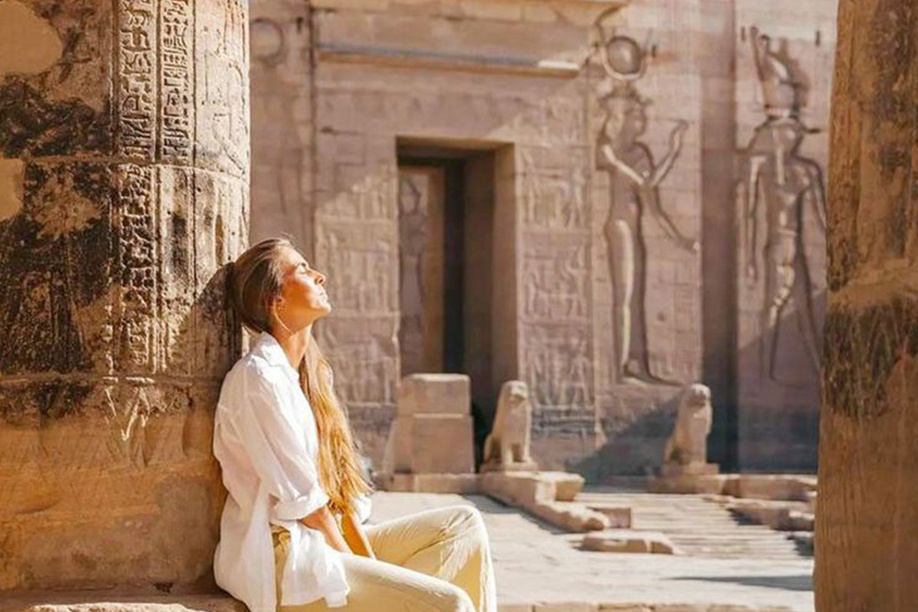
Breakfast on Board the Cruise
08:00 Proceed with Visits to Aswan
including the temple of Philae and a tour by Felucca around Elephantine, the High Dam, The
The Unfinished Obelisk was discovered in the early twentieth century after it had been covered by sand for thousands of years. Unfinished Obelisk
was discovered in the early twentieth century after it had been covered by sand for thousands of years.
The Unfinished Obelisk was discovered in the early twentieth century after it had been covered by sand for thousands of years. Unfinished Obelisk
Phiala temple :
Built to honour the goddess, Isis, this was the last temple built in the classical Egyptian style. Construction began around 690 BC, and it was one of the last outposts where the goddess was worshipped
The High Dam is a rock-fill dam located at the northern border between Egypt and Sudan.The dam is fed by the River Nile and the reservoir forms Lake Nasser The High Dam
:
Aswan High Dam is a rock-fill dam located at the northern border between Egypt and Sudan. The dam is fed by the River Nile and the reservoir forms Lake Nasser. Construction for the project began in 1960 and was completed in 1968. It was officially inaugurated in 1971.
The The
The Unfinished Obelisk was discovered in the early twentieth century after it had been covered by sand for thousands of years. Unfinished Obelisk
:
was discovered in the early twentieth century after it had been covered by sand for thousands of years.
Aswan was the source of ancient Egypt’s finest granite, used to make statues and embellish temples, pyramids, and obelisks. The large unfinished obelisk in the Northern Quarries has provided valuable insight into how these monuments were created, although the full construction process is still not entirely clear. Three sides of the shaft, nearly 42m long, were completed except for the inscriptions. At 1168 tonnes, the completed obelisk would have been the single heaviest piece of stone the Egyptians ever fashioned.
12:00 lunch on board of the Cruise
At 16:00 sailing trip with Felucca around Elphinatine island and visit Lord Kitchener island
Optional trip to the Nubian village:
The Nubian village is one of Aswan's attractions. It's worth visiting and spending 2 hours on. The place is very authentic and genuine, Colorful and artistic, the In Aswan
In Aswan
Nubian Village is a must visit to experience a traditional and very unique lifestyle. The Village is very colorful. Nubian Village
is a must-visit to experience a traditional and unique lifestyle. The Village is very colourful.
In Aswan
Nubian Village is a must visit to experience a traditional and very unique lifestyle. The Village is very colorful. Nubian Village
will surprise you in every corner! While walking in the village, you will straight away feel the soul of this place!
Dinner &overnight on board the Cruise

Breakfast on board the cruise.
Optional trip to The Great Temple of Abu Simbel, in Nubia near Egypt’s southern border,is among the most amazing monuments of Egypt. Abu Simbel temple s :
The two temples of Ramses the Second and the Queen Nefertari were carved out of the Mountain on the west bank of the Nile between 1274 and 1244 B.c, The Great Temple was dedicated to Ramses the Second, Ra-Harakhty, Amun Ra and Ptah, with 4 Colossal statues, The second temple was dedicated to Queen Nefertari and Goddess Hathor, and the two temples were dismantled stone by stone and rebuilt on higher ground, The preservation of the two temples of Abu Simbel must Rank as the greatest Achievement of the Unesco.
If you wish to do Abu Simbel on Day 4 instead of Day 5- we are flexible to do that
Transfer to the Airport of Aswan and fly to Cairo
Overnight in Cairo

Depart to the Airport from Your hotel in Cairo
Meals: Breakfast

Inclusions:
- Pick up service at Cairo Airport.
- 5 nights at Cairo bed and breakfast basis.
- 1-night camping in Baharya OAsis
- 2-nights in Alminya (bed and breakfast basis)
- 1-night In Abyods (bed and breakfast basis)
- 1 night in Luxor bed and breakfast basis.
- 4 nights Nile cruise. All-inclusive
- An escorted knowledgeable tour guide all over the tour.
- All your transportation during the tour with a private A.C car
- Entering fees for all the mentioned sightseeing on the itinerary.
- All Service Charges and taxes
- Flight tickets from Aswan to Cairo
Exclusions:
- International Airfare.
- Egypt entry visa.
- Tipping
- Optional Tours
Please remember to bring:
- Passports valid 6 months
- Hat
- Suncreams
- Sunglasses
Reviews
Trip FAQ - 15 days Egypt itinerary Cairo, El Minya and Nile cruise
Loading Questions...











